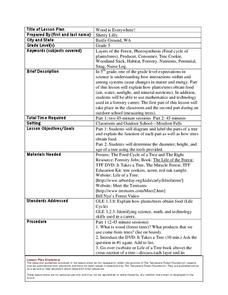California Polytechnic State University
Australian Geography Unit
At the heart of this resource is a beautifully detailed PowerPoint presentation (provided in PDF form) on the overall physical geography of Australia, basic facts about the country, Aboriginal history, and Australia culture and lifestyle.
Michigan State University
Create an Animal
Think beyond the animals and habitats we've already discovered and allow scholars to dream up their very own habitat and an animal that lives there. Class members present the new habitat and animal on a poster alongside an...
Northern Ireland Curriculum
Self Concept
It may not be possible to have control over all aspects of life, but through the activities and discussions in this lesson class members learn different ways to cope with those areas over which they have little or no control.
Curated OER
Pour Some
Students compare their desired portions with the actual serving size. In this activity on serving size, students compare their desired portion of a given food with the actual serving size listed on the Nutritional Facts label.
Curated OER
Health and Nutrition ESOL
Students bring cans of food to class to study and compare labels. They discuss the different information included and the importance of good nutrition. They create a one day menu that would maintain a healthy diet. They role play...
Curated OER
Beef Is Good For You
Young scholars discuss as a class the need for a healthy diet. They bring in a food product and analyze the nutrition label. Using the labels, they complete a worksheet and chart the nutrients found in beef. They use a scale to see...
Curated OER
Nutrition
Students learn about good nutrition. In this biology lesson plan, students test samples of food to find out if they contain fat, test fruit juices for vitamin C and compare the vitamin C content of the juices, calculate the number of...
Curated OER
Life Processes and Living Things-Humans and Other Animals
In this fill in the blank worksheet, students respond to 20 short answer questions by identifying foods that contain large amounts of sugar, carbohydrate, and fruit acids and explaining their effects on the body.
Curated OER
Understanding Portion Sizes
Students analyze portion sizes in a healthy diet. In this portion sizes lesson, students complete a food group choices worksheet and identify the correct portion of food. Students work in groups to teach the unit to elementary students....
Curated OER
Grocery Shopping and Budgeting
Ninth graders establish a food budget based on individual needs and resources. They evaluate grocery stores and establish guidelines for purchasing specific foods.
Curated OER
Starvation in the Ghettos
Young scholars consider the lack of nutrition experienced in Holocaust ghettos. For this Holocaust lesson, students investigate the Nazi policy of starving people out of the ghettos through their food rationing program. Young scholars...
Curated OER
Math: Party Time!
Twelfth graders discover how to calculate the total costs for a party. They determine the unit prices of food and supplies, the quantities needed, and complete a chart displaying their findings. Students calculate the costs per serving...
Curated OER
Digestive System, a Kinesthetic Lesson
Students actively act out an aspect of the digestive tract on two parallel strips of tape on the floor 3-4 feet apart and width of classroom which represent the digestive tract.
Curated OER
Purchasing Power
Learners participate in a lemonade sale and record their sales in a journal. For this fundraising lesson, students donate money they have raised from a lemonade sale and make a plan for how the money should be spent.
Curated OER
Edible Algae
Students acquire an awareness and appreciation for the value of the organisms in the Protist Kingdom. They identify common Protists, name them and list some common products that contain marine algae.
Curated OER
What Do Soils Have to Do With Me?
In this identifying ways we use soils every day worksheet, students investigate their houses, home environment, clothing labels, and foods to see what was made from things grown in soils. Students write 5 short answers.
Curated OER
Understanding Our Planet's Food Web
Sixth graders, in groups, examine how humans have a tenuous position as part of an ecosystem.
Curated OER
What's on Your Plate?
Students analyze the calorie content of food. In this health science instructional activity, students discuss how excess calories affect our body. They write a healthy meal plan for their family.
Curated OER
What's My Nutrition Value?
Second graders, in groups, explore how to read labels on food packages. They learn the nutritional value of food.
Curated OER
Truth in packaging
In this packaging worksheet, students complete a chart where they weigh packages and compare it to the label on the package. Students complete the chart for 5 packages and answer 3 questions.
Curated OER
What's In Your Grocery Bag?
Students explore the global implications of consumer decisions when purchasing groceries. They examine labels of food products and discuss the wording on the labels. They calculate food miles of how far each ingredient in foods has...
Curated OER
It's Sugar Time!
Fifth graders review the Food Pyramid. They examine several breakfast cereal labels and determine how much sugar is in each. They discuss these amounts and whether or not they are surprised by the results. They discuss the amount of...
Curated OER
Lunchroom Trash
Students explore the amount of waste produced by humans. In this ecology lesson, students predict which lunch bag and its contents will produce the most waste. Leftover material is examined, amounts are recorded, and a bar graph is...
Curated OER
Wood is Everywhere!
Fifth graders diagram and label the parts of a tree. For this lesson on how trees obtain food, 5th graders diagram and label the parts of a tree, and determine the diameter, height, and age of a tree.

























